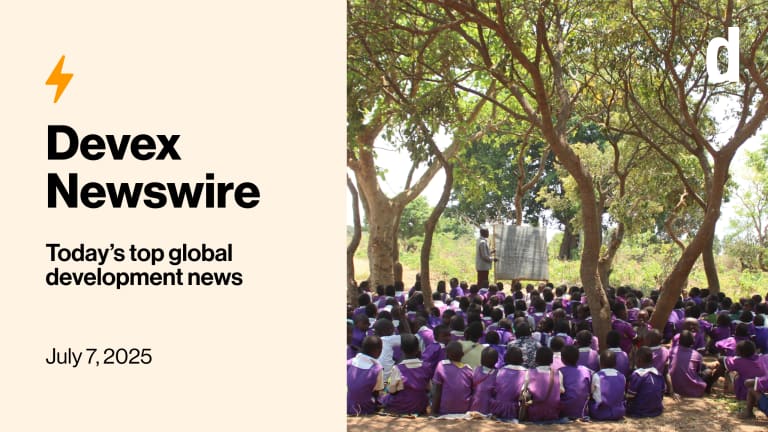Key insights for organizations providing WASH services in conflict
Everyone in the sector agrees there is a gap in emergency WASH services. Experts from Médecins Sans Frontières share recommendations for how to improve it.
When Médecins Sans Frontières researcher Andrew Cunningham set out to interview key players in water and sanitation, he found quick agreement about the problem: A huge gap in emergency WASH interventions. Few actors are providing even fewer services in the first three months of many humanitarian crises — a critical period for the health and well-being of those affected. There is less agreement on how to plug the holes in WASH coverage. MSF, a medical relief organization that will step in to provide emergency WASH when needed, set out to look for fixes. Cunningham’s report, published July 10, details the roots of the problem and discusses ideas on how to move forward. Specifically, the report looks at how individual organizations and the sector as a whole can improve its response. Organizations need more capacity, willingness, expertise and flexibility, while the sector needs to better sequence funding, rethink development approaches and better manage transitions to long-term WASH, Cunningham argues. Across the board, the report argues that organizations must be more willing to step in. At a time when many global crises are the result of conflict, more actors are risk averse in the initial months. Devex spoke with Cristina Imaz, a technical logistics advisor in the MSF Emergency Unit, about options for WASH in the field. MSF also shared an internally conducted interview with the report’s author. Here are a few of their recommendations for how to improve emergency WASH. Development approaches to WASH may not be fast-acting enough Many of the organizations working on WASH do so through the lens of development. They prioritize factors such as community participation and working through local groups. That level of investment on the “soft” side of WASH may be inappropriate in emergency settings, the report argues. In the initial three months of a crisis, securing basic goods and access should take precedence. One example comes from MSF’s toolkit: portable water treatment centers using river or lake water. “If you find a source of water, no matter how dirty, you can treat it, and you can set that up in a day,” says Imaz. “The technical solutions are there.” Yemen offers another example of urgent WASH needs. The country is currently host to the world’s worst cholera outbreak, a spiraling water-borne infection that has risen to nearly 315,000 cases since the spring. Clean water is a priority to control the epidemic, but most water in the country comes from privately owned boreholes. For now, MSF procures from various sources, treats it and trucks it to communities in need. This isn’t a sustainable fix, but it’s a necessary one for now, says Imaz. “During war maybe this is the emergency solution, but it’s costly and not every organization can assume it.” Keep an eye on the big picture Because there is no single organization focused specifically on emergency WASH, for now, everyone comes at it from their own angle. “Even if an organization intervenes in the emergency phase, only certain types of WASH needs are addressed,” Cunningham says. “For example, an organization may only provide WASH support to nutrition programing, or health programing, or may only be concerned with children or other specific vulnerable groups.” WASH is indeed vital to meeting a number of other objectives that relief groups are aiming toward. But focusing too specifically can leave gaps. For example, a medical intervention to promote access to clean water may neglect hygiene education, or a focus on nutrition may place less emphasis on the quality of the water supply. One result — and challenge — of the current WASH specificity is a lack of organizational capacity. Since many organizations do WASH work only for specific purposes and in certain contexts, their expertise closely follows. The sector is broadly lacking in technical expertise to conceptualize and implement comprehensive WASH programing. Do what’s possible today, plan for tomorrow At the height of an emergency, ideal solutions may be out of reach. Meeting organizational targets of liters of water per person, for example, may be unattainable in the first weeks or months. As a result, “you have to work in two speeds, with a view of ‘I need something today,’ and then, ‘this we need to improve in a month,’” urges Imaz. She points to latrines as an example. Immediately following a massive displacement, emergency latrines can be built in hours, often serving far greater than the ideal number of people. But organizations should consider that a stop gap, and then improve facilities as soon as possible. Setting organizational preferences can facilitate a two-track timeline. WASH implementers should understand what an ideal response looks like, and then decide upon numerous tiers of less-ideal interventions that align with what might be possible. Identify how to transition from emergency to long-term intervention from the get-go Two-track thinking may also help smooth the hand-off between emergency and development WASH approaches. At some point, emergency providers need to hand off their interventions to organizations with expertise in sustainability over a longer term. That switch is easier and less costly if it’s planned from the get-go, rather than improvised later on. “It is important to have an exit strategy in place from the beginning. It would also be good to have already identified a partner to hand over to,” said Cunningham. “And longer term, organizations need to be a bit more flexible in the types of programs they take over — programs will not always be in the state they prefer, but such is the reality of the transition.” “The basic idea is for both emergency and longer term oriented organizations to put more effort into figuring out the transition, and as early as possible.” Read more international development news online, and subscribe to The Development Newswire to receive the latest from the world’s leading donors and decision-makers — emailed to you free every business day.
When Médecins Sans Frontières researcher Andrew Cunningham set out to interview key players in water and sanitation, he found quick agreement about the problem: A huge gap in emergency WASH interventions. Few actors are providing even fewer services in the first three months of many humanitarian crises — a critical period for the health and well-being of those affected.
There is less agreement on how to plug the holes in WASH coverage. MSF, a medical relief organization that will step in to provide emergency WASH when needed, set out to look for fixes. Cunningham’s report, published July 10, details the roots of the problem and discusses ideas on how to move forward.
Specifically, the report looks at how individual organizations and the sector as a whole can improve its response. Organizations need more capacity, willingness, expertise and flexibility, while the sector needs to better sequence funding, rethink development approaches and better manage transitions to long-term WASH, Cunningham argues.
This story is forDevex Promembers
Unlock this story now with a 15-day free trial of Devex Pro.
With a Devex Pro subscription you'll get access to deeper analysis and exclusive insights from our reporters and analysts.
Start my free trialRequest a group subscription Printing articles to share with others is a breach of our terms and conditions and copyright policy. Please use the sharing options on the left side of the article. Devex Pro members may share up to 10 articles per month using the Pro share tool ( ).
Elizabeth Dickinson is a former associate editor at Devex. Based in the Middle East, she has previously served as Gulf correspondent for The National, assistant managing editor at Foreign Policy, and Nigeria correspondent at The Economist. Her writing also appeared in The New Yorker, Wall Street Journal, New York Times, Politico Magazine, and Newsweek, among others.








